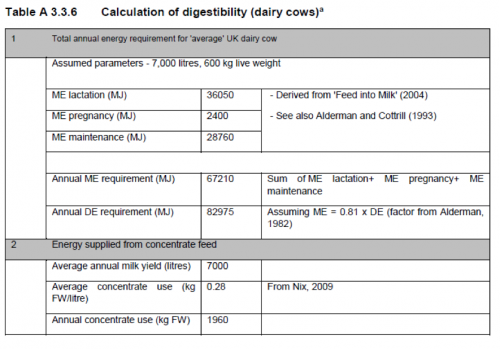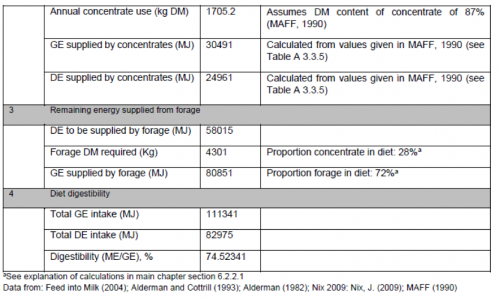Keywords: filling data gaps | feed digestibility | national energy balance model | dairy cattle
Country context: In the early 2000s, cattle contributed about one-third of UK total emissions of methane. In the early inventories, emission factors were separately estimated for four types of cattle (dairy breeding cows, beef cows, other cattle >1 year and other cattle <1 year. This was later increased to 8 sub-categories of cattle. Dairy cattle are a major source of emissions.
What data needs were addressed? Improved estimates of feed digestibility were needed.
Why was the data needed? The UK’s national GHG inventory implements the IPCC Tier 2 model for enteric fermentation and manure management, in which feed digestibility is an important input. When the Tier 2 model was first used, the UK used expert judgment and IPCC default values. Subsequently, improvements in knowledge in the dairy sector indicated that these prior estimates required revision.
Methods used: A national energy balance model developed for farm feed and nutrition planning was used.
How was the data gap addressed? For dairy cows, a country-specific approach to estimating digestibility of feed (DE%) has been developed. This country-specific approach is based on the models that underlie extension advice to farmers using the Feed into Milk (FiM) model. The reason for using this country-specific approach is that feed concentrate provides an important part of the dairy cow diet. The Feed into Milk model was developed to provide a better estimate of voluntary feed intake in order to better meet the energy and protein requirements of high-yielding dairy cows.
The FiM model was developed in the early 2000’s to replace earlier (1993) feed nutrition tables as the basis for software programs for use by farmers in feed and nutrition planning. The model has modules for the prediction of feed intake, energy requirements and supply, and protein requirements and supply.
Feed intake equations were specifically developed using data from cows fed on different diets in experiments at several UK research institutes and were validated against independent datasets. Thus, the equations can be used to predict feed intake across a range of forage and concentrate diets. The feed intake prediction equation uses information on concentrate intake and its protein content, body condition, live weight, milk energy output, week of lactation and starch content of forage. In particular, the feed intake equation developed predicts intake of grass silage-based diets more accurately than previous equations used to inform dairy nutrition advice.
Extension advice for dairy production in the UK has been based on the UK metabolizable energy (ME) feeding system, first proposed for use in the UK by the agricultural Research Council in 1965 (with revisions in 1980, 1990 and 1993). One strength of the system is that its mathematical structure enables it to easily be used in conjunction with feed value tables. The revision in FiM was needed to account for the higher genetic merit of modern cows, changes in representative diets and observed changes in ME requirements for maintenance. A new empirical model was made relating milk energy output (i.e. product of milk yield and gross energy concentration of the milk) and measured ME input, with full measurement of losses in feces, urine, methane and heat. The resulting equations predict ME requirements for maintenance and also the efficiency of ME use for lactation that varies with milk energy for lactation. On this basis, the total ME requirements for body weight gain, pregnancy, maintenance and milk production and activity can be estimated.


In the national GHG inventory, the FiM model is used to first estimate metabolizable energy for a typical level of milk production, in this case, 7000 liters. At this level of production, the farm management guide suggests average concentrate use of 0.28 kg per liter (Nix, 2009). The digestibility (DE as % of GE) value for concentrate feed (c. 82%) is estimated on the basis of a typical mix of protein and energy feed ingredients in concentrate. Using this value for ME supplied by concentrate, the annual ME requirement that has to be met from forage can then be derived. This is useful because the UK does not have detailed survey data on the amount of forage consumed by dairy cows. Assuming on the basis of expert opinion taking into account the proportion of time spent grazing by dairy cows that forage consists of 40% fresh grass, 50% grass silage and 10% maize silage, the relative proportions of concentrate to forage DM intake per year are estimated as 29% concentrate and 71% forage. The digestibility values for forage components are taken from the official feed nutrient value tables (MAFF, 1990).
The use of FiM is specifically for dairy cows. For beef cattle, digestibility values are based on expert opinion.
Further Resources
Thomas C. 2004. Feed into Milk: A new applied feeding system for dairy cows: An advisory manual.
Author: Andreas Wilkes, Values for development Ltd (2019)

